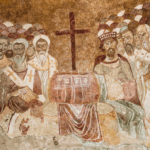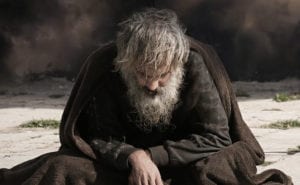This is the second post to a short series on the nature of gender. Click here to see the other posts in the series
In my introductory post, I argued that we need a new approach to thinking about sex and gender. It’s no longer enough to lay out the facts and rules; we need to talk about meaning. We need to show how our sexual lives and identities fit into the big story God is wanting to tell.
The Illusion of Individualism
Our hearts might recoil from that idea. Western individualism has trained us to believe that the good life means telling your own story: making your own choices; following your own hearts; expressing your own feelings about sex and gender.
And yet none of us is really an island. Our lives are massively shaped by the families, times, communities and nations we are born into. We are continually influenced, both consciously and unconsciously, by people upstream from us historically, politically, socially and culturally. Even our individualism is (in part) bred into us by our culture.
We humans never simply exist on our own. We also participate in others’ existence: we come from, and share in, other lives and realities. And these affect our own lives—sometimes for good and sometimes for evil. The better we understand those influences, the better we can live our own lives.
Patterns of Participation
The Bible is very big on these patterns of participation (see Appendix). The Old Testament shows God dealing with humans through representatives: prophets, priests and kings. It shows blessings, missions and curses flowing down the generations from fathers like Abraham, David and Cain. It teaches that the life of every human is affected by the primal rebellion of the first man, Adam. We are all born into a world of death and hardship because, long ago, our species went to war against its Maker.
And gender is about participation too—though of a different kind. More on that below.
Introducing Gender Sex and Marriage
Gender makes its first appearance in Genesis 1:27 where we learn that both “male and female” are created “in the image of God” and charged with the rule of creation. This is an important first word. It shows us the basic equality and common humanity of men and women—before God, before creation, and before each other.
But Genesis 1 doesn’t help us to understand gender itself. For that we need to read Genesis 2. Here, after he creates the first man to work and take care of the Garden of Eden, God observes that it is “not good for the man to be alone” and then proceeds to make Adam a companion and helper from his own body:
21 So the Lord God caused a deep sleep to fall upon the man, and while he slept took one of his ribs and closed up its place with flesh. 22 And the rib that the Lord God had taken from the man he made into a woman and brought her to the man.
23 Then the man said,
“This at last is bone of my bones
and flesh of my flesh; she shall be called Woman,
because she was taken out of Man.”
24 Therefore a man shall leave his father and his mother and hold fast to his wife, and they shall become one flesh. 25 And the man and his wife were both naked and were not ashamed.
(Genesis 2:21-24)
Here we learn the basic facts about men, women, gender and marriage:
Man
Man appears as a creature made from the ground to care for it on God’s behalf. His name “Adam” comes from the Hebrew for ground “Adamah”. “Adam” is also the Hebrew name for the human race that comes from him.
In verse 18, God observes that Adam needs a helper.[1] The passage doesn’t tell us what this involves exactly, but good guesses include help governing creation, or bearing children (given the mandate to multiply and fill the earth from Gen 1:28). Yet, both the way woman is made, and man’s response to her (vv23–24), seem to point to some sense of completion and companionship. (Of course, all of these answers might be true at once).
Woman
Woman is introduced to us here as a being created to meet the need of Adam. She is made from man and takes her name accordingly: she is called “Ishah” (from the Hebrew for male “Ish”) “because she was taken out of Man” (v23).
Taken in isolation this might communicate the idea that woman is wholly defined by man. But that would be to forget what we have already seen in Genesis 1—woman, just as much as man, bears God’s image and rules his creation. Chapter 2:18 speaks of her in terms of Adam’s equal-and-opposite.
Gender
Nevertheless Genesis 2 does indicate an asymmetry between the genders. If we take Genesis 2 as a more detailed retelling of Genesis 1:27 (“So God created man in his own image … male and female he created them”) then it seems that woman’s humanity comes from man. He is the one created first and entrusted with the care of the garden. She derives her nature from him,[2] arriving on stage as part of his story.[3]
But man belongs to woman too. Although woman is taken out of man, she comes back to him as another person with her own life and will. Thus in marriage, it’s not just woman who returns to her source, but man who leaves his father and his mother and cleaves to his wife (Gen 2:24). Paul writes accordingly that a man who has sex with a prostitute makes himself a member of her (1Cor 6:15-16); that husbands and wives have authority over each other’s bodies (1Cor 7:4). Finally, the apostle reminds us, that man is also born from woman—so neither sex is independent of the other (1Cor 11:11-12).
Gender, then, as we discover it here, is a network of relationships involving equality, participation and interdependence. It is not about social stereotypes or personal feelings or even innate characteristics. Some of those things may be important, but gender itself is about the way humans are made. It’s about the way they exist in relation to each other, and the way they live out God’s plan.
Gender is also true for everyone. Although gender is especially relevant to marriage (see the next point), it’s more basic—it’s the reality that makes marriage possible. Men as a class need women. And women as a class are from and for man. We’ll see some implications of this in future posts.
Marriage
Yet marriage is the primary reason why both sex and gender exist. Woman is created because it is not good for man to be alone—and the body God gives her allows enables her to be physically joined to him. Sexual relations between man and woman fulfil the purpose of gender—rejoining woman and man.
Accordingly, the immediate outcome of woman’s creation in Genesis 2 is described as union with the man: “Therefore, [i.e. because woman was taken out of man], man shall leave his father and his mother and hold fast to his wife, and they shall become one flesh” (v24).
Gender … and what Really Matters
Discussions of gender and gender-relations arouse strong feelings these days—and that shouldn’t surprise us. Genesis shows us that gender is a complex reality and it is hard to hold the elements in tension. Some stress equality—obscuring the order built into creation. Others over-emphasise participation, reducing women to accessories of man.
Gender is also fraught because there is a lot at stake. As Genesis 2 shows, men and women need each other in profound ways. Man’s existence is “not good” without woman. Woman in turn is (partly) defined by her creation from and for man. So problems in gender relations cut close to the bone.
Yet we mustn’t see them as all-important.
Man’s deepest need isn’t really for woman; nor is man woman’s real reason for existence. Both man and woman ultimately stand before God as his people. Their greatest need, duty and hope isn’t to be found in each other, but in him. If we make gender or sexuality substitute gods we’ll freight them with a burden they just can’t bear. It is only God who really defines our identity. It is only God who can provide us with the grace we need to live as men and women. In our next post we’ll see something of how that grace comes to us.
<— Previous Post … Next Post —>
Images: Michelangelo, detail from ‘Creation of Adam’ [body]; Byzantine mosaic, Palermo [head]
[1] As many others have pointed out, “helper” might not be the right word to use here, given its connotations of menial service. God himself is a helper of humans (eg Ps 54)—though we should remember that he is not created for man (whereas she is).
[2] This is the relationship of participation that I was referring to earlier. It seems to be why Paul, writing to the Corinthians, says that man is the “image and glory of God, but woman is the glory of man” (1Cor 11:7): both man and woman are equally made in God’s image, yet woman has it from man. So Ciampa and Rosner write: “[Paul] understands Adam to have been uniquely made in God’s image (without any human contribution), while God’s image was passed to Eve through Adam.” R. E. Ciampa & B. S. Rosner, The first letter to the Corinthians (Grand Rapids, Mich Nottingham, England: W.B. Eerdmans Pub. Co Apollos, 2010), 524.
[3] Some people point out that Adam is not called “ish” (male/man) until after the creation of woman—as if this undermined the idea that man was created first. Yet, although the observation is useful, the conclusion is misguided. The story leaves no doubt that the male who receives Eve in v 23 is the same human individual who was formed from the dust in v7. The point is made explicitly in 1Tim 2 and 1Cor 11.















